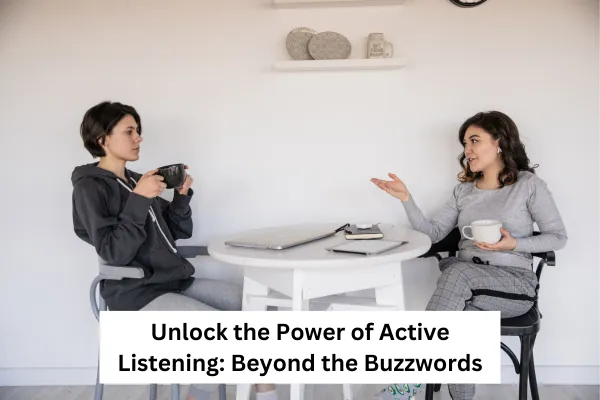Welcome To The Official Blog Of The
🎊 Attractive Relationships Podcast 🎊

Unlock the Power of Active Listening: Beyond the Buzzwords
We’ve all been there. You’re sitting in a corporate training session or leadership workshop, and the speaker throws out a phrase like active listening. Heads nod, pens scratch notes, and yet... no one seems to ask the obvious question: What does it actually mean to actively listen?
Too often, buzzwords like this are tossed around without substance, leaving us wondering how to implement them in real life. In this post, I’m going to break down what active listening really is, why it’s more than just a trendy phrase, and how you can use it to build stronger relationships at work and home.
What Active Listening is Not
Let’s start with what active listening isn’t. It’s not just nodding along, throwing in an “I hear you” or “That makes sense,” and then moving on to what you want to say. That kind of response doesn’t make the other person feel heard—it makes them feel dismissed.
Think about the last time you opened up about something important and got a response like, “I hear you, but…” Did that feel validating? Probably not. In fact, it likely left you feeling frustrated, like your words didn’t matter. That’s because true active listening requires more than a surface acknowledgment.
The Real Meaning of Active Listening
Active listening is about more than just understanding the words someone is saying—it’s about truly grasping their perspective and making them feel heard. When done well, it has two powerful effects:
1. It opens the other person’s mind to new ideas.
When someone feels understood, they’re far more likely to consider your input or feedback.
2. It builds trust and respect.
Feeling heard makes people feel valued, strengthening your connection with them.
How to Practice Active Listening
Here’s the good news: active listening isn’t as complicated as it might seem. It requires intentionality, empathy, and a little bit of practice. Let’s break it down:
1. Show Genuine Curiosity
When someone is speaking, approach the conversation with curiosity. Ask open-ended questions like, “What led you to that decision?” or “Can you tell me more about what you were thinking?” These questions signal that you’re invested in understanding their point of view.
2. Reflect Back What You Hear
Summarize what the person said in your own words. For example:
“So, you thought this approach made sense because of X, Y, and Z?”
When you get it right, the other person will often respond with, “That’s right.” This is your cue that they feel understood—and they’re more likely to open up even further.
3. Go Beyond the Words
Active listening isn’t just about the words being spoken; it’s about the emotions behind them. Pay attention to body language, tone, and facial expressions. These cues can tell you how someone really feels and help you respond with empathy.
4. Avoid the “I Hear You, But…” Trap
Nothing derails a conversation faster than following “I hear you” with a dismissive statement. Instead, validate the other person’s perspective fully before offering your input.
For example, instead of saying, “I hear you, but we need to do it this way,” try: “I can see why you approached it this way, and it makes sense given the information you had. Let’s explore some other options together.”
Why Active Listening Matters
When practiced effectively, active listening can transform your relationships. Here’s why: In the Workplace: Employees who feel heard are more engaged and receptive to feedback. Whether you’re a leader or a team member, active listening can help resolve conflicts, foster collaboration, and boost morale. At Home: With loved ones, active listening builds trust and intimacy. It shows that you value their feelings and experiences, even when you don’t fully agree. In Sales or Public Speaking: Even when you’re not in a direct conversation, the principles of active listening—such as reading the audience’s energy and responding empathetically—can help you connect and persuade.
Final Thoughts
Active listening isn’t just a buzzword—it’s a skill that can deepen your connections and help you navigate even the toughest conversations. It’s about making people feel seen, heard, and valued. Next time you’re in a conversation, challenge yourself to go beyond surface-level responses. Listen with intention. Validate their perspective. And watch how it transforms the way others respond to you. If you want to dive deeper into mastering communication skills like active listening, check out the Be Fearless and Effective Communicators Program here. It’s packed with actionable strategies to help you connect fearlessly and confidently in any situation.
